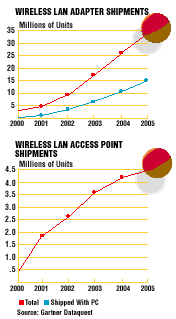Taking To The Air


Take Grady Crunk, executive vice president at Central Data, Titusville, Fla. About three years ago, the $62 million solution provider's sales and profit began to sag as vendors hiked direct-sales efforts, product margins bottomed out and the first winds of the recession chilled business and government IT spending. Central Data needed a lift, so Crunk altered the company's business model to differentiate it from competitors and create a new source of revenue. From scratch, he built the infrastructure needed to offer wireless solutions, which now account for more than one-third of Central Data's business.
"We didn't have a choice," Crunk said. "It was a matter of survival."
Central Data isn't alone. Other solution providers are networking towns, hospitals, office buildings and business facilities with wireless solutions that show clear returns on investment, yield high margins, reduce reliance on particular vendors and tighten customer relationships. Though some customers express concerns about wireless security and standards, their confidence in the technology increases after each successful project, and that often produces follow-up engagements, solution providers say.
Turnkey Computer Systems, for one, is using wireless as a growth vehicle. The New York-area solution provider, based in Clifton, N.J., has implemented about 20 wireless solutions over the past year, said Turnkey Computer Systems President Leonard DiCostanzo. "We got comfortable with simple solutions, but now we want to grow our client base through wireless and to continue rolling it out to our existing customers," DiCostanzo said.

\
Central Data's Crunk uses balloons to help align antennas for transmission and reception between wireless towers.
Industry executives and analysts say the attraction to wireless technology is simple: Customers want it. Last year, more than 50 vendors shipped 5.3 million wireless LAN adapter cards and 1.8 million wireless LAN access points worldwide, twice the number of adapter cards and nearly 20 times the number of access points shipped in 2000, according to research firm Gartner Dataquest. And the global market for wireless LAN equipment is projected to swell 22 percent year over year to about $3.4 billion in 2005 from $1.5 billion in 2001, the research firm said.
"Our wireless business is going through the roof," said Roy Appelbaum, vice president of marketing for networking and storage at Tech Data. The distributor's wireless product sales have grown 37 percent since fiscal 2001, he said. "We're past the early-adopter stage [with wireless technology, so manufacturers are producing a lot of great product. More and more cost-effective solutions are coming out on a daily basis."
And Central Data's Crunk has made the necessary investments to ensure that his firm can keep the wireless solutions coming. Central Data built a network operations center (NOC) to monitor customers' wired and wireless networks and provide them with an extra sense of security.
In addition, the company bought its own bucket truck for erecting relay towers to improve Internet speed and availability. Central Data used to pay a contractor close to $7,500 to put up the towers, but it now costs the company about $2,500 to do the job on its own, Crunk said.
"We bought the truck to let our customers know we were dead serious about wireless," he said. Central Data also floats its own red-and-yellow weather balloons in site surveys to help line up antennas. Crunk estimated that he's spent about $300,000 in equipment and training for wireless,an investment that paid for itself long ago. "The best thing is there are not a lot of people doing what we do," he said.

\
Downtime CEO Ted Hunter says wireless is a 'no-brainer' for his company, which makes a margin of about 25 percent on a typical wireless solution.
Wireless solutions now make up about 35 percent of Central Data's business, and the company expects that number to reach 80 percent by the end of next year, Crunk said, adding that the services-rich solutions carry average margins of 20 percent to 30 percent. And Central Data's remote services capabilities, which include 24-hour network monitoring and bandwidth regulation, have helped the firm win lucrative bids despite charging higher prices than competitors.
"Every single piece of our wireless solution has services tied to it," Crunk said. "For every dollar [the customer spends on hardware and software for a wireless solution, we receive a dollar in services. We don't even talk about product with our customers anymore."
Ted Hunter, CEO of Downtime, a small solution provider based in Brunswick, Maine, dove into wireless last fall as a way to upgrade existing clients with faster Internet speeds and develop new business through handheld computing solutions. Most of the solutions Downtime currently provides are half wired and half wireless, Hunter said.
"It's cheaper than cabling. We're not getting any complaints, and the drop-offs are a lot less than they used to be," Hunter said, adding that Downtime makes a margin of about 25 percent on a typical wireless solution. "The margins are really good because we'll charge the customer $100 for a [wired drop, and we can charge the same for wireless," he said. "But there's a lot less labor involved. We're making a killing on that. It's a no-brainer."
In a recent customer project, Downtime constructed a wireless network for a small oil company and included Compaq portable computers, which transformed the oil trucks into mobile offices. Hunter said the oil company already is saving money because it takes workers less time to file paperwork and they don't lose as many documents in transit.

The increasing deployment of such practical solutions will whet businesses' appetites for wireless technology and, in turn, boost service opportunities for solution providers, according to industry executives. "The opportunity for customers that want to deploy 'computing anywhere' solutions is about to explode," said Lucy Hinckley, manager of distribution channels for IBM's Pervasive Computing division. "For every dollar spent on software, services are a multiple of that."
Yet some hurdles loom for solution providers eyeing the wireless market, notably the standards issue. Most wireless products today are based on the 2.4GHz 802.11b standard, which accounted for 95 percent of wireless LAN adapters shipped in fourth-quarter 2001, according to Gartner Dataquest. Volume shipments of 5GHz 802.11a equipment are getting under way, but Gartner Dataquest predicts a slow adoption of 802.11a gear. The research firm also expects a gradual shift from 802.11b to 802.11g in the 2.4GHz realm but forecasts a market split between the faster 5GHz and cheaper 2.4GHz equipment by early 2005, with most 2.4GHz products supporting 802.11g. What's more, by mid-2004, Gartner Dataquest expects emerging security standards such as 802.11i to be required in all but the lowest-cost wireless products.
Like many solution provider executives, Tribeca Technologies CEO Gary Berzack finds the wireless LAN standards issue frustrating, but he doesn't let it dictate his business. He recently finished providing site survey, design and deployment work for the network infrastructure of rooftop access points throughout Hoboken, N.J. Tribeca Technologies built the 802.11b-based solution for My Way Wireless, a new service provider that plans to bring wireless access to towns and cities nationwide. Tribeca Technologies' next big job, which Berzack said he's not ready to discuss, will be based on both the 802.11b and 802.11a standards.
Although Tribeca Technologies is "ambidextrous" in wireless, keeping up with the standards remains a challenge, Berzack said. Because there are few 802.11a-based products on the market, the solution provider faces the question "of when to implement it and how to design around it," he said. The 802.11g standard,basically a second generation of 802.11b,competes with 802.11b for air space and has less throughput than 802.11a, according Berzack. "So it's all about timing," he said. "It's about the timing of deployments and the value of time, as opposed to price and bandwidth."
Despite the growth in wireless sales, many skilled solution providers say they are wary of entering the market because of the initial investment required and customer uncertainty about wireless security. But distributors Tech Data and Ingram Micro,along with vendors such as IBM, Cisco Systems, 3Com, SMC Networks and Agere Systems,are easing channel partners' entry into wireless by increasing the amount of bundled packages, specialized technicians, training, seminars and marketing funds available to VARs. And to overcome security concerns, solution providers say they're integrating the same best practices they apply to wired solutions.
"Solution providers are definitely running into more situations where wireless can be used," said Bill Brooks, Ingram Micro's senior director of technical support. "Economic, standardization and security concerns are still holding back wireless, but those will hopefully be overcome in the short term."
Turnkey Computer Systems' DiCostanzo said he has been impressed enough with the margins in wireless to make it a central focus of his business. The solution provider's coffer isn't overflowing with extra cash, so the company leveraged the new wireless initiative from Ingram Micro's VentureTech Network to get started. DiCostanzo said he'll tap the program's free training, offered in conjunction with IBM, and use available marketing funds to hold wireless seminars this summer in office buildings across the metro New York area.
"With the way business is going, you either grow or die. And we plan to grow with wireless," he said.
Over the past year, the scope of Central Data's wireless solutions has expanded to include security cameras and IP telephony. Coupled with Compaq (now Hewlett-Packard) iPaq handhelds, the solution is being snapped up by schools and large institutions as a way to enhance security, Crunk said. Central Data also is outfitting gambling cruise ships with wireless access points that have a five-mile range from ship to shore.
"Our wireless expertise has eliminated the competition," Crunk said. "Our customers can't get the services we offer anyplace else. We lock them in so they have no reason to go to another company."